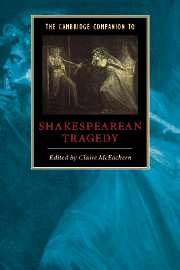Book contents
- Frontmatter
- 1 What is a Shakespearean tragedy?
- 2 The language of tragedy
- 3 Tragedy in Shakespeare’s career
- 4 Shakespearean tragedy printed and performed
- 5 Religion and Shakespearean tragedy
- 6 Tragedy and political authority
- 7 Gender and family
- 8 The tragic subject and its passions
- 9 Tragedies of revenge and ambition
- 10 Shakespeare’s tragedies of love
- 11 Shakespeare’s classical tragedies
- 12 The critical reception of Shakespeare’s tragedies
- 13 Antony and Cleopatra in the theatre
- Select bibliography
- Index
- Series List
1 - What is a Shakespearean tragedy?
Published online by Cambridge University Press: 28 May 2006
- Frontmatter
- 1 What is a Shakespearean tragedy?
- 2 The language of tragedy
- 3 Tragedy in Shakespeare’s career
- 4 Shakespearean tragedy printed and performed
- 5 Religion and Shakespearean tragedy
- 6 Tragedy and political authority
- 7 Gender and family
- 8 The tragic subject and its passions
- 9 Tragedies of revenge and ambition
- 10 Shakespeare’s tragedies of love
- 11 Shakespeare’s classical tragedies
- 12 The critical reception of Shakespeare’s tragedies
- 13 Antony and Cleopatra in the theatre
- Select bibliography
- Index
- Series List
Summary
‘Double, double toil and trouble . . .’
(Mac. 4.1.10)An eminent Shakespearean scholar famously remarked that there is no such thing as Shakespearean Tragedy: there are only Shakespearean tragedies. Attempts (he added) to find a formula which fits every one of Shakespeare's tragedies and distinguishes them collectively from those of other dramatists invariably meet with little success. Yet when challenging one such attempt he noted its failure to observe what he termed 'an essential part of the [Shakespearean] tragic pattern'; which would seem to imply that these plays do have some shared characteristics peculiar to them.
Nevertheless, objections to comprehensive definitions of ‘Shakespearean Tragedy’ are well founded. Such definitions tend to ignore the uniqueness of each play and the way it has been structured and styled to fit the particular source-narrative. More generally, they can obscure the fact that what distinguishes Shakespeare’s tragedies from everyone else’s and prompts us to consider them together are not so much common denominators but rather the power of Shakespeare’s language, his insight into character, and his dramaturgical inventiveness.
- Type
- Chapter
- Information
- The Cambridge Companion to Shakespearean Tragedy , pp. 1 - 22Publisher: Cambridge University PressPrint publication year: 2003
- 2
- Cited by



